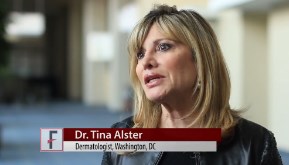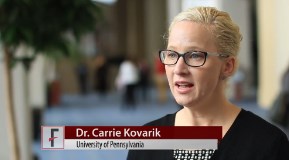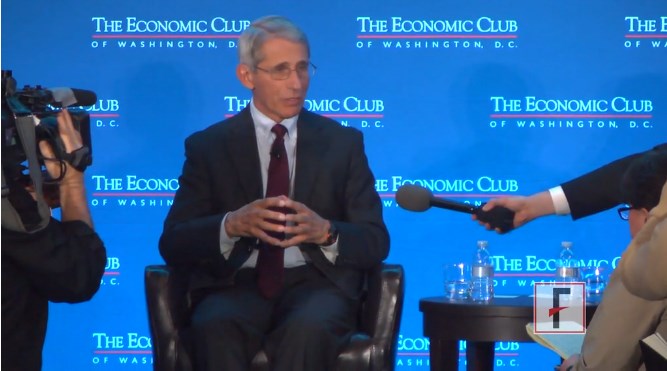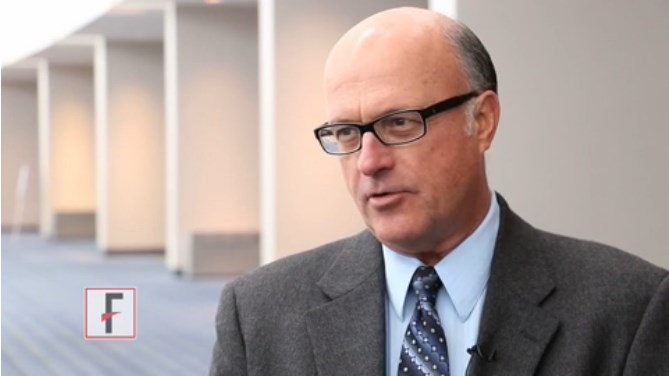User login
Ixekizumab approved for plaque psoriasis
Ixekizumab is approved to treat moderate to severe plaque psoriasis in adults, according to an announcement from the Food and Drug Administration.
“Today’s approval provides patients suffering from plaque psoriasis with another important treatment option to help relieve the skin irritation and discomfort from the condition,” Dr. Julie Beitz, director of the FDA’s Office of Drug Evaluation III, said in a statement .
Ixekizumab is an IgG4 monoclonal antibody that selectively binds with interleukin 17A (IL-17A) cytokines, inhibiting interaction with the IL-17 receptor. It is approved for patients who are candidates for systemic therapy, phototherapy, or a combination of both.
The safety and efficacy of ixekizumab were established in three randomized, placebo-controlled clinical trials with a total of 3,866 participants with plaque psoriasis who were candidates for systemic therapy or phototherapy. Patients treated with ixekizumab achieved greater clinical response than did those who received placebo.
The therapy was approved with a medication guide to inform patients that they may have a greater risk of an infection, or an allergic or autoimmune condition, according to the FDA announcement. The agency advised that physicians should monitor patient for serious allergic reactions and development or worsening of inflammatory bowel disease.
The most common adverse events seen in clinical trials of ixekizumab were upper respiratory infections, injection site reactions, and tinea.
Ixekizumab will be marketed as Taltz by Eli Lilly and Company.
On Twitter @denisefulton
Ixekizumab is approved to treat moderate to severe plaque psoriasis in adults, according to an announcement from the Food and Drug Administration.
“Today’s approval provides patients suffering from plaque psoriasis with another important treatment option to help relieve the skin irritation and discomfort from the condition,” Dr. Julie Beitz, director of the FDA’s Office of Drug Evaluation III, said in a statement .
Ixekizumab is an IgG4 monoclonal antibody that selectively binds with interleukin 17A (IL-17A) cytokines, inhibiting interaction with the IL-17 receptor. It is approved for patients who are candidates for systemic therapy, phototherapy, or a combination of both.
The safety and efficacy of ixekizumab were established in three randomized, placebo-controlled clinical trials with a total of 3,866 participants with plaque psoriasis who were candidates for systemic therapy or phototherapy. Patients treated with ixekizumab achieved greater clinical response than did those who received placebo.
The therapy was approved with a medication guide to inform patients that they may have a greater risk of an infection, or an allergic or autoimmune condition, according to the FDA announcement. The agency advised that physicians should monitor patient for serious allergic reactions and development or worsening of inflammatory bowel disease.
The most common adverse events seen in clinical trials of ixekizumab were upper respiratory infections, injection site reactions, and tinea.
Ixekizumab will be marketed as Taltz by Eli Lilly and Company.
On Twitter @denisefulton
Ixekizumab is approved to treat moderate to severe plaque psoriasis in adults, according to an announcement from the Food and Drug Administration.
“Today’s approval provides patients suffering from plaque psoriasis with another important treatment option to help relieve the skin irritation and discomfort from the condition,” Dr. Julie Beitz, director of the FDA’s Office of Drug Evaluation III, said in a statement .
Ixekizumab is an IgG4 monoclonal antibody that selectively binds with interleukin 17A (IL-17A) cytokines, inhibiting interaction with the IL-17 receptor. It is approved for patients who are candidates for systemic therapy, phototherapy, or a combination of both.
The safety and efficacy of ixekizumab were established in three randomized, placebo-controlled clinical trials with a total of 3,866 participants with plaque psoriasis who were candidates for systemic therapy or phototherapy. Patients treated with ixekizumab achieved greater clinical response than did those who received placebo.
The therapy was approved with a medication guide to inform patients that they may have a greater risk of an infection, or an allergic or autoimmune condition, according to the FDA announcement. The agency advised that physicians should monitor patient for serious allergic reactions and development or worsening of inflammatory bowel disease.
The most common adverse events seen in clinical trials of ixekizumab were upper respiratory infections, injection site reactions, and tinea.
Ixekizumab will be marketed as Taltz by Eli Lilly and Company.
On Twitter @denisefulton
VIDEO – Microneedling: Simple procedure offers good results for wrinkles, pores, and more
WASHINGTON – Microneedling is one of the hottest new trends in aesthetic dermatology and is easy to incorporate into any practice, according to Washington dermatologist Dr. Tina Alster.
Microneedling involves using an updated microneedle device to create small wounds on a patient’s area of concern. Perioral wrinkles, large pores on the nose, certain scars, and stretch marks all respond well to the procedure, Dr. Alster said at the annual meeting of the American Academy of Dermatology.
“I’ve been blown away by the fact that microneedling works as well as it does,” Dr. Alster added, noting that it’s not hard to do, it’s not hard to heal from, and it offers good results.
In this video interview, Dr. Alster explains how to do this microneedling procedures and how to incorporate the device into practice.
On Twitter @denisefulton
WASHINGTON – Microneedling is one of the hottest new trends in aesthetic dermatology and is easy to incorporate into any practice, according to Washington dermatologist Dr. Tina Alster.
Microneedling involves using an updated microneedle device to create small wounds on a patient’s area of concern. Perioral wrinkles, large pores on the nose, certain scars, and stretch marks all respond well to the procedure, Dr. Alster said at the annual meeting of the American Academy of Dermatology.
“I’ve been blown away by the fact that microneedling works as well as it does,” Dr. Alster added, noting that it’s not hard to do, it’s not hard to heal from, and it offers good results.
In this video interview, Dr. Alster explains how to do this microneedling procedures and how to incorporate the device into practice.
On Twitter @denisefulton
WASHINGTON – Microneedling is one of the hottest new trends in aesthetic dermatology and is easy to incorporate into any practice, according to Washington dermatologist Dr. Tina Alster.
Microneedling involves using an updated microneedle device to create small wounds on a patient’s area of concern. Perioral wrinkles, large pores on the nose, certain scars, and stretch marks all respond well to the procedure, Dr. Alster said at the annual meeting of the American Academy of Dermatology.
“I’ve been blown away by the fact that microneedling works as well as it does,” Dr. Alster added, noting that it’s not hard to do, it’s not hard to heal from, and it offers good results.
In this video interview, Dr. Alster explains how to do this microneedling procedures and how to incorporate the device into practice.
On Twitter @denisefulton
AT AAD 16
VIDEO: Expert – Skin signs to watch for in HIV patients
WASHINGTON – While the widespread use of antiretroviral therapy in the United States has markedly reduced the prevalence of cutaneous manifestations of HIV and AIDS, dermatologists still may see patients who present with cutaneous manifestations of undiagnosed infections, including aggressive human papillomavirus infections, according to Dr. Carrie L. Kovarik.
Dr. Kovarik of the department of dermatology, University of Pennsylvania, Philadelphia, recommended seeing these patients more frequently – perhaps every month or 2 – to monitor HPV infection and genital warts. Even in patients who now have more robust immune systems, those who were once immunocompromised are at risk of malignant generation of their genital warts.
Dr. Kovarik discusses that, as well as hypersensitivity reactions to some HIV and tuberculosis treatments, in an interview at the annual meeting of the American Academy of Dermatology.
The video associated with this article is no longer available on this site. Please view all of our videos on the MDedge YouTube channel
On Twitter @denisefulton
WASHINGTON – While the widespread use of antiretroviral therapy in the United States has markedly reduced the prevalence of cutaneous manifestations of HIV and AIDS, dermatologists still may see patients who present with cutaneous manifestations of undiagnosed infections, including aggressive human papillomavirus infections, according to Dr. Carrie L. Kovarik.
Dr. Kovarik of the department of dermatology, University of Pennsylvania, Philadelphia, recommended seeing these patients more frequently – perhaps every month or 2 – to monitor HPV infection and genital warts. Even in patients who now have more robust immune systems, those who were once immunocompromised are at risk of malignant generation of their genital warts.
Dr. Kovarik discusses that, as well as hypersensitivity reactions to some HIV and tuberculosis treatments, in an interview at the annual meeting of the American Academy of Dermatology.
The video associated with this article is no longer available on this site. Please view all of our videos on the MDedge YouTube channel
On Twitter @denisefulton
WASHINGTON – While the widespread use of antiretroviral therapy in the United States has markedly reduced the prevalence of cutaneous manifestations of HIV and AIDS, dermatologists still may see patients who present with cutaneous manifestations of undiagnosed infections, including aggressive human papillomavirus infections, according to Dr. Carrie L. Kovarik.
Dr. Kovarik of the department of dermatology, University of Pennsylvania, Philadelphia, recommended seeing these patients more frequently – perhaps every month or 2 – to monitor HPV infection and genital warts. Even in patients who now have more robust immune systems, those who were once immunocompromised are at risk of malignant generation of their genital warts.
Dr. Kovarik discusses that, as well as hypersensitivity reactions to some HIV and tuberculosis treatments, in an interview at the annual meeting of the American Academy of Dermatology.
The video associated with this article is no longer available on this site. Please view all of our videos on the MDedge YouTube channel
On Twitter @denisefulton
AT AAD 16
Uncontrolled hidradenitis suppurativa costs the health care system
WASHINGTON – One in four hidradenitis suppurativa patients saw their disease become more severe, requiring significantly more health care resources and driving up health care spending.
Dr. Alexa Boer Kimball, professor of dermatology at Harvard Medical School, Boston, and her colleagues reviewed commercial claims in the OptumHealth Reporting and Insights Database from 1998 through early 2014, identifying 1,314 adult patients treated for hidradenitis suppurativa (HS). About a quarter of these patients (323) experienced an increase in the severity of their disease, represented by an inpatient or emergency department visit or skin surgery performed on the same day as a dermatologic diagnosis. Their findings were presented at the annual meeting of the American Academy of Dermatology.
“Patients with hidradenitis suppurativa use a substantial level of health care resources, especially given their relatively young age,” Dr. Kimball said in an interview. “The results of this study suggest that if we can implement effective therapies that prevent patients from progressive disease, we may not only be able to improve their outcomes but also meaningfully reduce costs to the health care system.”
Patients who progressed to a more severe form of HS had significantly more outpatient visits (incidence rate ratio, 1.35), as well as inpatient visits (IRR, 2.48), emergency department visits (IRR, 1.71), and other medical service visits (IRR, 1.81), compared with those whose disease did not progress (all, P less than .001).
The most common indicators of disease progression included skin surgery (62%) and the initiation of a strong pain reliever (34%), Dr. Kimball noted.
Health care costs for patients whose disease progressed was $5,052 higher than were costs for those whose disease did not progress. Cost increases were driven mainly by higher outpatient costs and high inpatient costs (for both, P less than .05). Differences in pharmacy costs were not statistically significant.
“To date, no guidelines are available in the United States for the management of hidradenitis suppurativa and, until very recently, there was no treatment approved in the U.S.,” Dr. Kimball and her colleagues said.
Adalimumab gained Food and Drug Administration approval for moderate to severe HS in 2015.
On Twitter @denisefulton
WASHINGTON – One in four hidradenitis suppurativa patients saw their disease become more severe, requiring significantly more health care resources and driving up health care spending.
Dr. Alexa Boer Kimball, professor of dermatology at Harvard Medical School, Boston, and her colleagues reviewed commercial claims in the OptumHealth Reporting and Insights Database from 1998 through early 2014, identifying 1,314 adult patients treated for hidradenitis suppurativa (HS). About a quarter of these patients (323) experienced an increase in the severity of their disease, represented by an inpatient or emergency department visit or skin surgery performed on the same day as a dermatologic diagnosis. Their findings were presented at the annual meeting of the American Academy of Dermatology.
“Patients with hidradenitis suppurativa use a substantial level of health care resources, especially given their relatively young age,” Dr. Kimball said in an interview. “The results of this study suggest that if we can implement effective therapies that prevent patients from progressive disease, we may not only be able to improve their outcomes but also meaningfully reduce costs to the health care system.”
Patients who progressed to a more severe form of HS had significantly more outpatient visits (incidence rate ratio, 1.35), as well as inpatient visits (IRR, 2.48), emergency department visits (IRR, 1.71), and other medical service visits (IRR, 1.81), compared with those whose disease did not progress (all, P less than .001).
The most common indicators of disease progression included skin surgery (62%) and the initiation of a strong pain reliever (34%), Dr. Kimball noted.
Health care costs for patients whose disease progressed was $5,052 higher than were costs for those whose disease did not progress. Cost increases were driven mainly by higher outpatient costs and high inpatient costs (for both, P less than .05). Differences in pharmacy costs were not statistically significant.
“To date, no guidelines are available in the United States for the management of hidradenitis suppurativa and, until very recently, there was no treatment approved in the U.S.,” Dr. Kimball and her colleagues said.
Adalimumab gained Food and Drug Administration approval for moderate to severe HS in 2015.
On Twitter @denisefulton
WASHINGTON – One in four hidradenitis suppurativa patients saw their disease become more severe, requiring significantly more health care resources and driving up health care spending.
Dr. Alexa Boer Kimball, professor of dermatology at Harvard Medical School, Boston, and her colleagues reviewed commercial claims in the OptumHealth Reporting and Insights Database from 1998 through early 2014, identifying 1,314 adult patients treated for hidradenitis suppurativa (HS). About a quarter of these patients (323) experienced an increase in the severity of their disease, represented by an inpatient or emergency department visit or skin surgery performed on the same day as a dermatologic diagnosis. Their findings were presented at the annual meeting of the American Academy of Dermatology.
“Patients with hidradenitis suppurativa use a substantial level of health care resources, especially given their relatively young age,” Dr. Kimball said in an interview. “The results of this study suggest that if we can implement effective therapies that prevent patients from progressive disease, we may not only be able to improve their outcomes but also meaningfully reduce costs to the health care system.”
Patients who progressed to a more severe form of HS had significantly more outpatient visits (incidence rate ratio, 1.35), as well as inpatient visits (IRR, 2.48), emergency department visits (IRR, 1.71), and other medical service visits (IRR, 1.81), compared with those whose disease did not progress (all, P less than .001).
The most common indicators of disease progression included skin surgery (62%) and the initiation of a strong pain reliever (34%), Dr. Kimball noted.
Health care costs for patients whose disease progressed was $5,052 higher than were costs for those whose disease did not progress. Cost increases were driven mainly by higher outpatient costs and high inpatient costs (for both, P less than .05). Differences in pharmacy costs were not statistically significant.
“To date, no guidelines are available in the United States for the management of hidradenitis suppurativa and, until very recently, there was no treatment approved in the U.S.,” Dr. Kimball and her colleagues said.
Adalimumab gained Food and Drug Administration approval for moderate to severe HS in 2015.
On Twitter @denisefulton
AT AAD 2016
Key clinical point: Effective therapies that prevent patients with hidradenitis suppurativa from progressive disease may improve outcomes while reducing health care costs.
Major finding: Costs for patients whose HS progressed was $5,052 higher than those whose disease did not.
Data source: Review of commercial claims database identifying 1,314 adults with HS.
Disclosures: The study was supported by AbbVie. Dr. Kimball disclosed financial relationships with AbbVie, Janssen, Novartis, and Amgen, and one of her colleagues is an AbbVie employee.
SDEF: Severe acne responds to fixed-combo gel
A convenient, once-daily fixed combination of 0.3% adapalene plus 2.5% benzoyl peroxide gel significantly improved lesion counts over the course of 12 weeks in patients aged 12 years and older with moderate or severe acne.
Investigators enrolled just over 500 patients from 31 sites in the United States and Canada. About half of patients were rated as having severe acne and half as having moderate acne on the investigator’s global assessment (IGA) scale, Dr. Linda F. Stein Gold said at the Hawaii Dermatology Seminar provided by Global Academy for Medical Education/Skin Disease Education Foundation.
Patients were randomized to three treatment groups: adapalene 0.3%/benzoyl peroxide 2.5% gel (A-BPO-0.3%), adapalene 0.1%/benzoyl peroxide 2.5% (A-BPO-0.1%), or vehicle. Patients in each group had approximately the same total lesion count, and about half in each group had truncal acne lesions, said Dr. Stein Gold, director of clinical research in the department of dermatology at Henry Ford Hospital, Detroit.
Patients were instructed to use their study medications once daily at night after washing with a provided cleanser. They were provided with a standardized moisturizer and cleaners.
Treatment with A-BPO-0.3% was judged as successful (IGA of 1 or almost clear) at 12 weeks in 31% of patients with severe acne. By contrast, 13.3% of patients with severe acne were judged as almost clear. In patients with severe acne, A-BPO-1% was not statistically superior to vehicle (J Drugs Dermatol. 2015 Dec 1;14[12]:1427-35).
“Topical treatment is still the cornerstone of acne therapy, and it is great to have additional options, especially for our more severe acne patients,” Dr. Stein Gold said.
Patients noted dryness, scaling, erythema, and stinging/burning with A-BPO-0.3%, especially between weeks 1 and 2.
Dr. Stein Gold disclosed that she serves as a consultant and scientific advisory board member to Galderma, which markets A-BPO-0.3% as Epiduo Forte.
SDEF and this news organization are owned by the same parent company.
On Twitter @denisefulton
A convenient, once-daily fixed combination of 0.3% adapalene plus 2.5% benzoyl peroxide gel significantly improved lesion counts over the course of 12 weeks in patients aged 12 years and older with moderate or severe acne.
Investigators enrolled just over 500 patients from 31 sites in the United States and Canada. About half of patients were rated as having severe acne and half as having moderate acne on the investigator’s global assessment (IGA) scale, Dr. Linda F. Stein Gold said at the Hawaii Dermatology Seminar provided by Global Academy for Medical Education/Skin Disease Education Foundation.
Patients were randomized to three treatment groups: adapalene 0.3%/benzoyl peroxide 2.5% gel (A-BPO-0.3%), adapalene 0.1%/benzoyl peroxide 2.5% (A-BPO-0.1%), or vehicle. Patients in each group had approximately the same total lesion count, and about half in each group had truncal acne lesions, said Dr. Stein Gold, director of clinical research in the department of dermatology at Henry Ford Hospital, Detroit.
Patients were instructed to use their study medications once daily at night after washing with a provided cleanser. They were provided with a standardized moisturizer and cleaners.
Treatment with A-BPO-0.3% was judged as successful (IGA of 1 or almost clear) at 12 weeks in 31% of patients with severe acne. By contrast, 13.3% of patients with severe acne were judged as almost clear. In patients with severe acne, A-BPO-1% was not statistically superior to vehicle (J Drugs Dermatol. 2015 Dec 1;14[12]:1427-35).
“Topical treatment is still the cornerstone of acne therapy, and it is great to have additional options, especially for our more severe acne patients,” Dr. Stein Gold said.
Patients noted dryness, scaling, erythema, and stinging/burning with A-BPO-0.3%, especially between weeks 1 and 2.
Dr. Stein Gold disclosed that she serves as a consultant and scientific advisory board member to Galderma, which markets A-BPO-0.3% as Epiduo Forte.
SDEF and this news organization are owned by the same parent company.
On Twitter @denisefulton
A convenient, once-daily fixed combination of 0.3% adapalene plus 2.5% benzoyl peroxide gel significantly improved lesion counts over the course of 12 weeks in patients aged 12 years and older with moderate or severe acne.
Investigators enrolled just over 500 patients from 31 sites in the United States and Canada. About half of patients were rated as having severe acne and half as having moderate acne on the investigator’s global assessment (IGA) scale, Dr. Linda F. Stein Gold said at the Hawaii Dermatology Seminar provided by Global Academy for Medical Education/Skin Disease Education Foundation.
Patients were randomized to three treatment groups: adapalene 0.3%/benzoyl peroxide 2.5% gel (A-BPO-0.3%), adapalene 0.1%/benzoyl peroxide 2.5% (A-BPO-0.1%), or vehicle. Patients in each group had approximately the same total lesion count, and about half in each group had truncal acne lesions, said Dr. Stein Gold, director of clinical research in the department of dermatology at Henry Ford Hospital, Detroit.
Patients were instructed to use their study medications once daily at night after washing with a provided cleanser. They were provided with a standardized moisturizer and cleaners.
Treatment with A-BPO-0.3% was judged as successful (IGA of 1 or almost clear) at 12 weeks in 31% of patients with severe acne. By contrast, 13.3% of patients with severe acne were judged as almost clear. In patients with severe acne, A-BPO-1% was not statistically superior to vehicle (J Drugs Dermatol. 2015 Dec 1;14[12]:1427-35).
“Topical treatment is still the cornerstone of acne therapy, and it is great to have additional options, especially for our more severe acne patients,” Dr. Stein Gold said.
Patients noted dryness, scaling, erythema, and stinging/burning with A-BPO-0.3%, especially between weeks 1 and 2.
Dr. Stein Gold disclosed that she serves as a consultant and scientific advisory board member to Galderma, which markets A-BPO-0.3% as Epiduo Forte.
SDEF and this news organization are owned by the same parent company.
On Twitter @denisefulton
EXPERT ANALYSIS FROM SDEF HAWAII DERMATOLOGY SEMINAR
Sexually transmitted Zika case confirmed in Texas
A report of sexually transmitted Zika virus infection has been confirmed in Texas, according to officials at the Dallas County Health and Human Services Department (DCHHS).
The patient was infected with Zika virus via sexual contact with an individual who returned home after becoming ill in a country where the virus is present. The department received confirmation from the U.S. Centers for Disease Control and Prevention on Feb. 2.
“Now that we know Zika virus can be transmitted through sex, this increases our awareness campaign in educating the public about protecting themselves and others,” Zachary Thompson, DCHHS director, said in a statement.
See the full statement here.
On Twitter @denisefulton
A report of sexually transmitted Zika virus infection has been confirmed in Texas, according to officials at the Dallas County Health and Human Services Department (DCHHS).
The patient was infected with Zika virus via sexual contact with an individual who returned home after becoming ill in a country where the virus is present. The department received confirmation from the U.S. Centers for Disease Control and Prevention on Feb. 2.
“Now that we know Zika virus can be transmitted through sex, this increases our awareness campaign in educating the public about protecting themselves and others,” Zachary Thompson, DCHHS director, said in a statement.
See the full statement here.
On Twitter @denisefulton
A report of sexually transmitted Zika virus infection has been confirmed in Texas, according to officials at the Dallas County Health and Human Services Department (DCHHS).
The patient was infected with Zika virus via sexual contact with an individual who returned home after becoming ill in a country where the virus is present. The department received confirmation from the U.S. Centers for Disease Control and Prevention on Feb. 2.
“Now that we know Zika virus can be transmitted through sex, this increases our awareness campaign in educating the public about protecting themselves and others,” Zachary Thompson, DCHHS director, said in a statement.
See the full statement here.
On Twitter @denisefulton
VIDEO: Dr. Anthony S. Fauci addresses the Zika virus situation
WASHINGTON – The outbreak of Zika virus infection in scores of countries and territories in Central and South America has raised many questions for physicians and their patients.
Dr. Anthony S. Fauci, director of the National Institute of Allergy and Infectious Diseases, explained the current situation to business leaders at a meeting held by the Economic Club and took the time to answer some concerns of practicing physicians. Dr. Fauci was joined on the dais by David Rubenstein, president of the Economic Club.
See Dr. Fauci’s comments here.
On Twitter @denisefulton
WASHINGTON – The outbreak of Zika virus infection in scores of countries and territories in Central and South America has raised many questions for physicians and their patients.
Dr. Anthony S. Fauci, director of the National Institute of Allergy and Infectious Diseases, explained the current situation to business leaders at a meeting held by the Economic Club and took the time to answer some concerns of practicing physicians. Dr. Fauci was joined on the dais by David Rubenstein, president of the Economic Club.
See Dr. Fauci’s comments here.
On Twitter @denisefulton
WASHINGTON – The outbreak of Zika virus infection in scores of countries and territories in Central and South America has raised many questions for physicians and their patients.
Dr. Anthony S. Fauci, director of the National Institute of Allergy and Infectious Diseases, explained the current situation to business leaders at a meeting held by the Economic Club and took the time to answer some concerns of practicing physicians. Dr. Fauci was joined on the dais by David Rubenstein, president of the Economic Club.
See Dr. Fauci’s comments here.
On Twitter @denisefulton
AT A MEETING OF THE ECONOMIC CLUB OF WASHINGTON, D.C.
Alectinib FDA approved to treat metastatic ALK-positive NSCLC*
[UPDATE: 5:04 pm] Alectinib has been approved by the Food and Drug Administration for the treatment of patients with metastatic ALK-positive non–small cell lung cancer (NSCLC) who have been treated unsuccessfully with crizotinib.
Alectinib was approved based on data from two single-arm clinical trials of patients with crizotinib-refractory metastatic ALK-positive NSCLC.
One study, conducted in North America, included 87 patients who were treated with 600 mg of oral alectinib twice daily. A total of 38% of patients experienced a reduction in tumor size with a 7.5-month duration of response. In the second trial with the same treatment regimen, conducted globally, 44% of patients saw a reduction in tumor size with an 11.2-month duration of response.
Treatment with alectinib also reduced the size of brain metastases in 61% of patients in a pooled subset of patients in both trials, with a 9.1-month duration of response.
The most common adverse events were fatigue, constipation, edema, and myalgias.
“Today’s approval provides a new therapy for a group of patients who would have few treatment options once their disease no longer responds to treatment with [crizotinib],” Dr. Richard Pazdur, director of the Office of Hematology and Oncology Products in the FDA Center for Drug Evaluation and Research, said in a written statement. “In addition to the primary effect on tumors in the lung, [alectinib] clinical trials provide evidence of an effect on tumors that had spread to the brain, which is an important effect for clinicians to understand.”
Alectinib will be marketed as Alecensa by Genentech. It was approved under several FDA accelerated approval programs. Treatment with alectinib is expected to cost approximately $12,500 per month, according to a Genentech spokesperson.*
On Twitter @denisefulton
*This story has been updated with cost information.
*Correction, 12/21/2015: An earlier version of this story misspelled metastatic.
[UPDATE: 5:04 pm] Alectinib has been approved by the Food and Drug Administration for the treatment of patients with metastatic ALK-positive non–small cell lung cancer (NSCLC) who have been treated unsuccessfully with crizotinib.
Alectinib was approved based on data from two single-arm clinical trials of patients with crizotinib-refractory metastatic ALK-positive NSCLC.
One study, conducted in North America, included 87 patients who were treated with 600 mg of oral alectinib twice daily. A total of 38% of patients experienced a reduction in tumor size with a 7.5-month duration of response. In the second trial with the same treatment regimen, conducted globally, 44% of patients saw a reduction in tumor size with an 11.2-month duration of response.
Treatment with alectinib also reduced the size of brain metastases in 61% of patients in a pooled subset of patients in both trials, with a 9.1-month duration of response.
The most common adverse events were fatigue, constipation, edema, and myalgias.
“Today’s approval provides a new therapy for a group of patients who would have few treatment options once their disease no longer responds to treatment with [crizotinib],” Dr. Richard Pazdur, director of the Office of Hematology and Oncology Products in the FDA Center for Drug Evaluation and Research, said in a written statement. “In addition to the primary effect on tumors in the lung, [alectinib] clinical trials provide evidence of an effect on tumors that had spread to the brain, which is an important effect for clinicians to understand.”
Alectinib will be marketed as Alecensa by Genentech. It was approved under several FDA accelerated approval programs. Treatment with alectinib is expected to cost approximately $12,500 per month, according to a Genentech spokesperson.*
On Twitter @denisefulton
*This story has been updated with cost information.
*Correction, 12/21/2015: An earlier version of this story misspelled metastatic.
[UPDATE: 5:04 pm] Alectinib has been approved by the Food and Drug Administration for the treatment of patients with metastatic ALK-positive non–small cell lung cancer (NSCLC) who have been treated unsuccessfully with crizotinib.
Alectinib was approved based on data from two single-arm clinical trials of patients with crizotinib-refractory metastatic ALK-positive NSCLC.
One study, conducted in North America, included 87 patients who were treated with 600 mg of oral alectinib twice daily. A total of 38% of patients experienced a reduction in tumor size with a 7.5-month duration of response. In the second trial with the same treatment regimen, conducted globally, 44% of patients saw a reduction in tumor size with an 11.2-month duration of response.
Treatment with alectinib also reduced the size of brain metastases in 61% of patients in a pooled subset of patients in both trials, with a 9.1-month duration of response.
The most common adverse events were fatigue, constipation, edema, and myalgias.
“Today’s approval provides a new therapy for a group of patients who would have few treatment options once their disease no longer responds to treatment with [crizotinib],” Dr. Richard Pazdur, director of the Office of Hematology and Oncology Products in the FDA Center for Drug Evaluation and Research, said in a written statement. “In addition to the primary effect on tumors in the lung, [alectinib] clinical trials provide evidence of an effect on tumors that had spread to the brain, which is an important effect for clinicians to understand.”
Alectinib will be marketed as Alecensa by Genentech. It was approved under several FDA accelerated approval programs. Treatment with alectinib is expected to cost approximately $12,500 per month, according to a Genentech spokesperson.*
On Twitter @denisefulton
*This story has been updated with cost information.
*Correction, 12/21/2015: An earlier version of this story misspelled metastatic.
Senate votes to gut ACA, defund Planned Parenthood
WASHINGTON – Several key provisions of the Affordable Care Act would be repealed – and Planned Parenthood would be defunded for a year – under the fiscal year 2016 federal budget reconciliation bill passed Dec. 3 by the Senate.
Building on a budget reconciliation bill (H.R. 3762) passed by the House in October, the legislation would:
• Repeal the individual mandate and the employer mandate to provide health insurance coverage and the associated tax penalties.
• Phase out Medicaid expansion after a 2-year transition period.
• Eliminate federal subsidies to help patients purchase health insurance via the federal health care marketplace.
• Repeal the “Cadillac tax” on high-value health insurance plans.
• Repeal the medical device tax.
• Defund Planned Parenthood for a year and divert some of that funding to community health centers.
The bill passed 52-47, mostly along party lines. Sen. Mark Kirk (R-Ill.) voted with the Democratic minority and Sen. Bernie Sanders (I-Vt.) was absent.*
Senate Majority Leader Mitch McConnell (R-Ky.) hailed the vote. “For years, the American people have been calling on Washington to build a bridge away from Obamacare. For years, Democrats prevented the Senate from passing legislation to do so. But in just a moment, that will change,” he said, calling the vote “a victory for the middle-class families who’ve endured this law’s pain for too long.”
From the Senate floor, Minority Leader Harry Reid (D-Nev.) condemned the action. “Sometimes I wonder what Senate Republicans do when they’re not here in Washington, D.C. Do they talk to their constituents? Do they meet with them? I have a hard time believing my Republican friends are spending much time listening to their constituents’ concerns because it seems that what they are doing runs counter to the needs of their constituents,” Sen. Reid said. “This absurd attempt to repeal the Affordable Care Act through reconciliation is a perfect example.”
The bill now must be considered again by the House since it is not identical to the bill that body passed Oct. 23. Regardless, President Obama is unlikely to sign the bill.
On Twitter @denisefulton
Correction 12/7/15 : An earlier version of this article misstated two senators' votes.
WASHINGTON – Several key provisions of the Affordable Care Act would be repealed – and Planned Parenthood would be defunded for a year – under the fiscal year 2016 federal budget reconciliation bill passed Dec. 3 by the Senate.
Building on a budget reconciliation bill (H.R. 3762) passed by the House in October, the legislation would:
• Repeal the individual mandate and the employer mandate to provide health insurance coverage and the associated tax penalties.
• Phase out Medicaid expansion after a 2-year transition period.
• Eliminate federal subsidies to help patients purchase health insurance via the federal health care marketplace.
• Repeal the “Cadillac tax” on high-value health insurance plans.
• Repeal the medical device tax.
• Defund Planned Parenthood for a year and divert some of that funding to community health centers.
The bill passed 52-47, mostly along party lines. Sen. Mark Kirk (R-Ill.) voted with the Democratic minority and Sen. Bernie Sanders (I-Vt.) was absent.*
Senate Majority Leader Mitch McConnell (R-Ky.) hailed the vote. “For years, the American people have been calling on Washington to build a bridge away from Obamacare. For years, Democrats prevented the Senate from passing legislation to do so. But in just a moment, that will change,” he said, calling the vote “a victory for the middle-class families who’ve endured this law’s pain for too long.”
From the Senate floor, Minority Leader Harry Reid (D-Nev.) condemned the action. “Sometimes I wonder what Senate Republicans do when they’re not here in Washington, D.C. Do they talk to their constituents? Do they meet with them? I have a hard time believing my Republican friends are spending much time listening to their constituents’ concerns because it seems that what they are doing runs counter to the needs of their constituents,” Sen. Reid said. “This absurd attempt to repeal the Affordable Care Act through reconciliation is a perfect example.”
The bill now must be considered again by the House since it is not identical to the bill that body passed Oct. 23. Regardless, President Obama is unlikely to sign the bill.
On Twitter @denisefulton
Correction 12/7/15 : An earlier version of this article misstated two senators' votes.
WASHINGTON – Several key provisions of the Affordable Care Act would be repealed – and Planned Parenthood would be defunded for a year – under the fiscal year 2016 federal budget reconciliation bill passed Dec. 3 by the Senate.
Building on a budget reconciliation bill (H.R. 3762) passed by the House in October, the legislation would:
• Repeal the individual mandate and the employer mandate to provide health insurance coverage and the associated tax penalties.
• Phase out Medicaid expansion after a 2-year transition period.
• Eliminate federal subsidies to help patients purchase health insurance via the federal health care marketplace.
• Repeal the “Cadillac tax” on high-value health insurance plans.
• Repeal the medical device tax.
• Defund Planned Parenthood for a year and divert some of that funding to community health centers.
The bill passed 52-47, mostly along party lines. Sen. Mark Kirk (R-Ill.) voted with the Democratic minority and Sen. Bernie Sanders (I-Vt.) was absent.*
Senate Majority Leader Mitch McConnell (R-Ky.) hailed the vote. “For years, the American people have been calling on Washington to build a bridge away from Obamacare. For years, Democrats prevented the Senate from passing legislation to do so. But in just a moment, that will change,” he said, calling the vote “a victory for the middle-class families who’ve endured this law’s pain for too long.”
From the Senate floor, Minority Leader Harry Reid (D-Nev.) condemned the action. “Sometimes I wonder what Senate Republicans do when they’re not here in Washington, D.C. Do they talk to their constituents? Do they meet with them? I have a hard time believing my Republican friends are spending much time listening to their constituents’ concerns because it seems that what they are doing runs counter to the needs of their constituents,” Sen. Reid said. “This absurd attempt to repeal the Affordable Care Act through reconciliation is a perfect example.”
The bill now must be considered again by the House since it is not identical to the bill that body passed Oct. 23. Regardless, President Obama is unlikely to sign the bill.
On Twitter @denisefulton
Correction 12/7/15 : An earlier version of this article misstated two senators' votes.
VIDEO: AAP policy aims to protect young football players from head injury
WASHINGTON – Youth football coaches and officials should adopt a “zero tolerance” policy regarding dangerous, illegal head-first tackling, according to a policy statement from the American Academy of Pediatrics.
Dr. Gregory L. Landry, a pediatrician at the University of Wisconsin, Madison, presented the policy statement in a plenary session at the AAP annual meeting.
“In looking at the data, we could not find a case for banning tackling in youth football. The injury rate in youth football is relatively low, compared to the older boys and girls,” Dr. Landry, who coauthored the statement, said in a video interview. “We were a little bit worried that if we banned tackling at the youth level it would increase the injury rate when older kids learn how to tackle when they are bigger and more powerful.”
The policy also calls for the following:
• Players must decide whether the benefits of playing outweigh the risks of possible injury.
• Nontackling leagues should be expanded so athletes can choose to participate without the injury risks associated with tackling.
• Skilled athletic trainers should be available on the sidelines, as evidence shows they can reduce the number of injuries for players.
See the video interview with Dr. Landry below.
The video associated with this article is no longer available on this site. Please view all of our videos on the MDedge YouTube channel
On Twitter @denisefulton
WASHINGTON – Youth football coaches and officials should adopt a “zero tolerance” policy regarding dangerous, illegal head-first tackling, according to a policy statement from the American Academy of Pediatrics.
Dr. Gregory L. Landry, a pediatrician at the University of Wisconsin, Madison, presented the policy statement in a plenary session at the AAP annual meeting.
“In looking at the data, we could not find a case for banning tackling in youth football. The injury rate in youth football is relatively low, compared to the older boys and girls,” Dr. Landry, who coauthored the statement, said in a video interview. “We were a little bit worried that if we banned tackling at the youth level it would increase the injury rate when older kids learn how to tackle when they are bigger and more powerful.”
The policy also calls for the following:
• Players must decide whether the benefits of playing outweigh the risks of possible injury.
• Nontackling leagues should be expanded so athletes can choose to participate without the injury risks associated with tackling.
• Skilled athletic trainers should be available on the sidelines, as evidence shows they can reduce the number of injuries for players.
See the video interview with Dr. Landry below.
The video associated with this article is no longer available on this site. Please view all of our videos on the MDedge YouTube channel
On Twitter @denisefulton
WASHINGTON – Youth football coaches and officials should adopt a “zero tolerance” policy regarding dangerous, illegal head-first tackling, according to a policy statement from the American Academy of Pediatrics.
Dr. Gregory L. Landry, a pediatrician at the University of Wisconsin, Madison, presented the policy statement in a plenary session at the AAP annual meeting.
“In looking at the data, we could not find a case for banning tackling in youth football. The injury rate in youth football is relatively low, compared to the older boys and girls,” Dr. Landry, who coauthored the statement, said in a video interview. “We were a little bit worried that if we banned tackling at the youth level it would increase the injury rate when older kids learn how to tackle when they are bigger and more powerful.”
The policy also calls for the following:
• Players must decide whether the benefits of playing outweigh the risks of possible injury.
• Nontackling leagues should be expanded so athletes can choose to participate without the injury risks associated with tackling.
• Skilled athletic trainers should be available on the sidelines, as evidence shows they can reduce the number of injuries for players.
See the video interview with Dr. Landry below.
The video associated with this article is no longer available on this site. Please view all of our videos on the MDedge YouTube channel
On Twitter @denisefulton
AT THE AAP NATIONAL CONFERENCE









